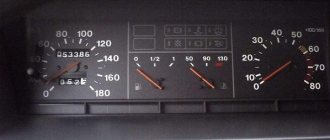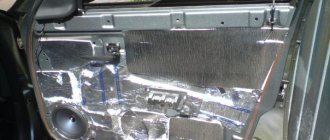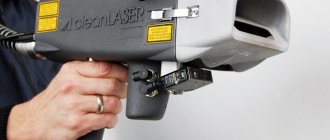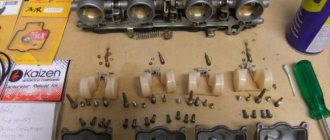If the car begins to move forward not straight, but sideways, it means it has skidded. Both experienced drivers and newbies face this problem. The most common cause is improper braking. In theory, it’s not difficult to figure out why a car skids. But when the problem occurs in real life, many cannot connect theory and practice.
When the speed decreases, the car is braked by the engine. The rear wheels move to the side and traction is lost. A similar problem can be encountered not only in winter on slippery roads. Skidding can happen to any driver in winter, summer or autumn. No panic, a strong grip on the steering wheel, the desire to do everything possible to minimize the negative consequences for the car and one’s own health - the main thing the driver must do.
Table of contents
- Reasons for skidding
- What not to do
- How to get out of a skid
- Correct driving position
- Is it possible to predict a skid?
It is important to consolidate theoretical cornering skills in practice. You can do this at the Racing Academy, where professional racers give extreme driving lessons.
First you need to understand why a skid occurs and what to do when a skid occurs. Knowing the factors that lead to it, you can reduce possible damage to the car and driver. When driving, he will take into account the likelihood of danger and avoid mistakes.
Yuz
Each wheel of a moving car has a certain coefficient of adhesion to the road surface. The value of this coefficient depends on many factors (travel speed, road surface material, tire pressure, vehicle load, weather conditions, wheel tire design, and much more). Calculating the coefficient of adhesion for a specific car in a specific situation is difficult and unnecessary. You only need to understand that the car “holds” to the road with a certain effort and that this effort is not unlimited.
Let's look at an example with braking. If it is necessary to reduce the speed, one driver simply removes the gas, another presses the brake pedal a little, and the third “with square eyes” puts so much pressure on the brakes that a little more and his foot along with the pedal will end up in the engine compartment.
In the latter case, the car’s wheels are no longer able to “cling” to the road; they become blocked and begin to slide. The car goes into skidding mode (no skidding yet).
Skidding is the sliding of car wheels on the road surface.
Most often, skidding begins due to excessive force when pressing the brake pedal. However, skidding can also occur when the gas pedal is pressed too hard “to the floor,” as a result of which the car’s wheels turn in place. When cornering at high speed, lateral skidding may occur, which is characterized by a specific “squealing of rubber.”
In other words, if the driver’s unreasonable actions have led to the car’s wheels slipping relative to the road surface, then he has the opportunity to experience the phenomenon of skidding, and later skidding.
Reasons for skidding
There is no need to confuse front axle drift and skidding. These are completely different situations. Understeer causes the front axle to drift. This is how demolition happens. When moving in a straight line, the car can also skid. This occurs when the sides of the machine move on different surfaces. Theoretical knowledge is quite enough for safety.
Lack of response and measures taken at the wrong time lead to uncontrolled skidding. The car turns around its axis. The best outcome of the situation is when the vehicle spins a little and you stop. In the worst case, you can fly off the road, collide with other road users, and cause a major accident. Statistically, skidding of the rear axle of a rear-wheel drive car happens more often. However, it is possible that the situation could also happen with front-wheel drive cars.
Reasons for skidding:
- tire rupture or damage;
- too much acceleration on a bad road;
- worn tire treads;
- sudden engagement of the clutch;
- various bulk materials under the wheels;
- hitting a stone or ice block;
- the pressure in the wheels does not correspond to standard parameters or the pressure is different;
- malfunction or failure of the brake system;
- steering wheel jerking in different directions.
The reasons for the problem could be listed for a long time. Many of them are directly related to mistakes made by car drivers. Trying to overtake other road users, make a maneuver, or drive onto an uneven section of the road, they contribute to the car skidding. When there is a sudden change in the coefficient of adhesion, in 99% of cases the car skids. It can also lead to more dangerous situations. For example, loss of control over two wheels.
All-wheel drive vehicles and their skidding
Most ordinary motorists and extreme driving experts agree that getting out of a skid in front-wheel drive cars is the most difficult task.
The main problem is that the gas pedal affects all 4 wheels of the vehicle at once. And each of the wheels accounts for a certain share of the torque coming to them from the engine.
Several important characteristics are taken into account here:
- type of all-wheel drive used;
- features of differential settings;
- selected all-wheel drive control mode;
- presence or absence of a stabilization system;
- use of electronic security systems, etc.
Therefore, we can say with confidence that each all-wheel drive crossover or SUV requires an individual approach to finding optimal solutions and actions to get out of a skid.
It is impossible to give advice that will certainly help the driver cope with a skid if the car has all-wheel drive. But there is one rule for everyone. It consists of turning the steering wheel in the direction of the skid itself. As for the gas pedal, here you have to be extremely careful and careful. Experts advise pressing the accelerator pedal until the moment so as not to lose traction. You cannot press the gas to the floor, as in the case of front-wheel drive cars, or remove your foot completely, as in rear-wheel drive cars, in the case of all-wheel drive.
What not to do
Rear-wheel drive skidding can be aggravated by excessive turning. Adjust the wheels in the desired direction. Always keep your hands on the steering wheel. This will help you feel their position in order to react in time if necessary. If the rear of the car points to the left, then we turn the steering wheel to the left. You need to turn the steering wheel without effort, in moderation. Better practice. In practice, this technique must be perfectly honed. Our Racing Academy will teach you how to cope with any driving situation. Author's training programs will help you gain the skills necessary for a driver - from beginner to professional.
Imagine the situation - you are driving along the road and the car starts to skid. Of course, every driver intuitively immediately wants to press the brake pedal. This is the most common mistake. You can't brake at all when skidding. The driver must remain calm and act quickly. If you have a rear-wheel drive car, you need to start slowly releasing the gas. And on front-wheel drive cars, sometimes you need to add a little more gas.
Are you having problems driving a car? Look at our programs and choose the one that suits you. Emergency training Restoration of driving skills Parking
Controlled skidding on all-wheel drive
The driver of an all-wheel drive vehicle will find himself in the most difficult situation, because “4 by 4” vehicles have a sensitive feel for the gas pedal and do not really like skidding turns. If you completely release the gas, the car will turn around its axis; if you press it too hard, the result will be the same: the car will be carried off the road. To avoid getting into trouble, as soon as you feel that the car is going into a skid, you need to turn the steering wheel in the direction of the skid and adjust the fuel supply. Intuitively: more is less. Cars with all-wheel drive are the most capricious to drive in skidding conditions. The driver must very accurately balance the gas and steering. Mastering this skill takes practice and training.
A car with all-wheel drive is the most difficult option to control in a skid.
How to get out of a skid
Panic is the driver's main enemy. Even if you feel like you're losing control, you shouldn't panic. In this regard, many car enthusiasts make mistakes. First of all, stay calm and refrain from making sudden movements. The following tips will help you prepare for the problem in advance.
Rear drive
For rear-wheel drive vehicles, there is a sequence of actions to stabilize the vehicle on the road. Skidding of such cars often occurs on slippery roads due to sudden maneuvers and high speed. To minimize uncontrolled skidding:
- you need to act immediately, you need to squeeze the clutch all the way, and take your foot off the gas, and this needs to be done at the same time;
- if the car has an automatic transmission, just don’t press the gas;
- Turn the steering wheel in the direction where the car is skidding.
You must act strictly in this sequence. This will prevent you from flying off the road and causing an accident.
Front-wheel drive
It is quite possible to prevent dangerous situations due to skidding at the end of a maneuver. To do this, follow the algorithm of actions.
Instructions:
- The main rule is to turn the steering wheel in the direction in which the car is driving.
- Turn the steering wheel in the correct direction.
- For front-wheel drive cars, you won't have to take your foot off the gas.
- There are situations when you need to press the gas a little.
- Remember that the force of the skid depends on the pressure on the accelerator.
- When entering it, do not press harder than 30%.
- When skidding deeply, press the pedal to the floor.
A prompt response will minimize or completely avoid consequences. If the car is turned around, it is useless to take action. This is why it is so important to be able to deal with the problem in practice.
Four-wheel drive
An all-wheel drive vehicle requires a separate approach. There are no universal tips on how to behave correctly when skidding. It is important to follow the rule, as in the situation with rear-wheel drive and front-wheel drive cars, to turn the steering wheel in the right direction. The correct one is always the one into which the car takes you. For example, the type of drive, what control mode, whether there is a stabilization system or not. Drivers are often interested in what to do when skidding in all-wheel drive. This task is considered the most difficult.
The gas pedal must be depressed smoothly without losing traction. In any case, the road alignment measures used for rear-wheel drive and front-wheel drive vehicles will not be suitable for all-wheel drive SUVs or crossovers. Therefore, owners of such cars need to practice getting out of a skid in a real situation.
Taking a turn on a slippery road
If on a slippery road when turning you feel that the car is not turning into the turn, but is being carried away, you should not turn the steering wheel even more in the direction of the turn, but return it closer to the straight position. Just enough so that the front wheels do not slide, but catch on the surface. And then we direct the car into a turn with its rear wheels: on front-wheel drive, the rear wheels are stopped due to the handbrake, on rear-wheel drive, this is a short slip. We perform a measured slide - a controlled skid. The button on the handbrake must be pressed all the time so as not to lock the rear wheels. Handbrake operation should be measured, braking should be short. You can make a few jerks to point the car in the desired direction. Only by controlling the gas supply can you pull the car out of a skid, with minimal steering effort.
Taking a turn on a slippery road
Correct driving position
Proper fit is very important. This will allow the driver to feel the force on the car and the angle of inclination. This information can be used as a hint as to where to turn the steering wheel. The seating position should be adjusted from the pedal assembly. Press the brake pedal all the way down. It is necessary that the knee is almost completely straightened with a slight bend.
To create a good tactile connection with the car, you need to press your foot firmly against the seat. To feel the forces acting on the car, install the backrest vertically. Many people find this situation uncomfortable. But in a critical situation it will help.
To check the correct distance of the steering column, press your back firmly against the seat, extend your arm straight and place it on top of the steering wheel. The rim should be under your wrist. This position facilitates precise operation of the steering wheel. An incorrect seating position reduces concentration and leads to rapid driver fatigue. All this does not make it possible to adequately respond to a critical moment in motion.
Features of all-wheel drive vehicles
All-wheel drive: traction distribution schemes on all wheels
The all-wheel drive vehicle flaunts clever features that attract the attention of consumers:
- has the most efficient acceleration dynamics;
- tends to overcome difficult off-road areas;
- able to easily climb ice slides.
However, not every all-wheel drive transmission is capable of efficiently implementing these characteristics. However, even the full implementation of immediate tasks does not occur in an uncompromising manner. Much depends on the layout of the all-wheel drive :
- constant;
- connected by means of automation;
- manually connected.
Permanent all-wheel drive in winter: features and difficulties
The full all-wheel drive layout ensures that power is constantly circulated between the engine and the front and rear axles. The main structural unit of the system is a transfer case , which distributes traction between two cross-axle differentials. The node includes :
- center differential;
- a locking device that provides a rigid connection between the front and rear axles (viscous coupling, friction clutch, self-locking differential);
- a chain transmission through which torque is supplied to the front axle shaft.
It is the full-fledged all-wheel drive that is an indispensable assistant in winter : power is supplied to all 4 wheels continuously both on asphalt and off-road, and the instantly activated lock allows you to confidently storm the snow-covered “intersection”.
The classic emphasis on the cross-country ability of a permanent all-wheel drive vehicle is made to the detriment of other qualities:
- large mass;
- obviously increased fuel consumption;
- the complexity of the design implementation, significantly increasing the cost of the option.
Universal technological solution: plug-in all-wheel drive
A hybrid alternative to a permanent 4x4 distribution scheme - front-wheel drive with an electronically connected rear axle on demand . The transmission layout is a complicated version of the “front-wheel drive”:
- The front axle differential is traditionally connected to the gearbox;
- primitive transfer case: bevel gear that transmits torque from the front axle to the cardan drive;
- unit connecting the rear axle: viscous coupling or friction unit.
The electronic continuously variable power distribution is tempting:
- relatively low cost of the product;
- small dimensions and weight of components;
- a slight increase in fuel consumption compared to the front-wheel drive version.
However, the solution is quite a compromise:
- on off-road and snowy areas, a blocked clutch is prone to rapid overheating and failure;
- on a normal highway, the car is practically in front-wheel drive mode (a small amount of power is transferred to the rear axle - up to 10-20%);
- full use of the rear axle is only possible when the front wheels slip or start.
It is worth noting that it is very difficult to prevent skidding with all-wheel drive of this arrangement . A sudden transmission of torque to the rear wheels, which occurs when the front axle slips, will require precious actions from the driver.
Conservative approach: manual all-wheel drive
By eliminating the differential from the full-fledged all-wheel drive system and replacing the electronic locking with the possibility of manual connection through the “transfer case” of the front axle, you can get a primitive small-sized mechanical all-wheel drive system. The design inherent to purely off-road vehicles has the following features :
- resistance to large mechanical loads;
- in the activated state, a 50/50 ratio is ensured;
- when turned on, reliable mechanics can ruin the transmission on the asphalt;
- switching occurs with the vehicle stationary.
Is it possible to predict a car skidding?
One sharp maneuver, incorrect braking or jerking the steering wheel to the sides and the car skidded. Inducing a skid is quite easy, unlike feeling it. Not everyone can predict that a skid will happen. For a beginner who recently received a license, it is almost impossible to feel the problem.
The ability to sense a skid in advance comes with driving experience. When driving one car for a long time, you begin to predict the behavior of vehicles on the road. Experienced drivers immediately understand that there is a problem somewhere. Therefore, they can immediately stabilize the car and minimize the consequences.
The Anton Zakharov Racing Academy provides driving training for everyone. Both professionals and beginners can sign up for driving lessons. The original programs that are developed at the school include the achievement of the skills necessary for a driver. We have extreme driving courses, driving courses for children, for experienced drivers who have a license. If parking is a problem for you or you want to learn how to drift, sign up for a course.
Behavior under traction
It is generally accepted that all-wheel drive behaves unpredictably when sliding. This is not so, there is logic. And after a series of training, the driver is able to understand it and take the right actions in order to maintain control over the car: stop the skid or use it to turn the car and position it correctly on the road. Another question is that the behavior of a car depends on what forces act on it in certain situations. The design features of the all-wheel drive transmission and the settings of the safety electronics also contribute.
Let's take for example a classic of the genre - permanent all-wheel drive with a symmetrical self-locking center differential. It, as we have already said, was used on many Japanese cars in the 1990-2000s, as well as on large Audi models with a longitudinal engine. This scheme is relatively simple and reliable, but it can be called the least predictable due to the fact that under traction the car’s understeer can become either insufficient or excessive, which can confuse the average driver.
In fact, there is logic in such changeability of character. How such a car will behave in a turn depends on the speed of its rotation relative to the vertical axis at the moment the “gas” is added.
Let's imagine that we are driving in a straight line, then turn the steering wheel and press the gas. You expect that on a slippery surface the car will immediately skid and go in an arc under the traction. If the front wheels have enough “grip”, so it will be. But if you work the steering wheel too hard or change the steering angle (and on a very slippery surface this is elementary), under the traction you will first experience a drift phase, then a sliding of all four wheels, and only after that the skidding will begin. The same thing will happen when turning, if the front wheels slip when you apply the gas.
How quickly things will reach the desired third phase (skidding) depends on when the front wheels still catch on the surface (the more slippery it is, the more difficult it is to achieve this). But by that time, the car can easily drive off the road without having time to turn. And in this way, in its behavior it will resemble front-wheel drive.
Let's do it differently: before pressing the gas, let's make the car actively turn. You can simply turn the steering wheel, and if it’s slippery, use additional methods: loading the front wheels by releasing the “gas” or “braking with the left,” counter-shift, or even using the handbrake. In general, you first need to make the car turn without a hint of drift - and then when you press the gas, it will behave like a rear-wheel drive one - “swing its tail” under traction.
Of course, depending on the technical features (for example, how the center differential is locked, whether there are center locks, what the weight distribution is along the axles, etc.), the behavior may vary from model to model. But the general principle is this.
As for other all-wheel drive schemes, models with permanent front-wheel drive and a connected rear axle are, as a rule, more prone to understeer under traction, that is, when you press the gas, there is a greater likelihood of drift occurring, the transition to skidding occurs later and requires more active actions on the part of the driver.
Cars with an asymmetrical center differential or models with a clutch in the drive of the front wheels (for example, modern BMW xDrive) have torque distribution in favor of the rear wheels and in their behavior under traction are more reminiscent of the “classics”: the likelihood of drift occurs, but it is less It is easier to provoke a skid and it is easier to drive the car in it, the main thing is not to overdo it with the angle and speed of rotation relative to the vertical axis.
That is, as we see, despite the possible different behavior, there are certain reasons for it to be this way or that. Understanding this relationship, learning to recognize the signs of this or that behavior, knowing what and how to do, and most importantly, having practiced the skills, you can quite confidently control all-wheel drive in sliding and be fully a driver, and not a passenger behind the wheel of a sliding AWD.











